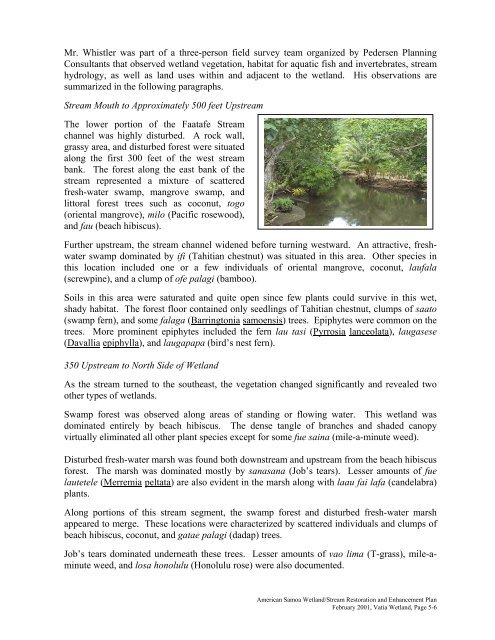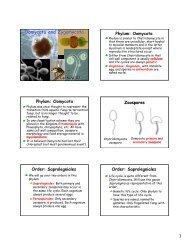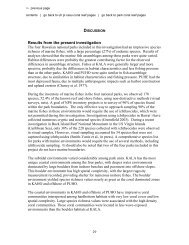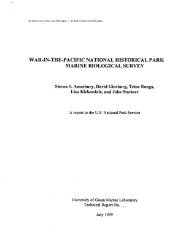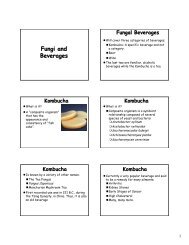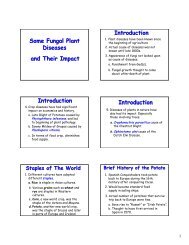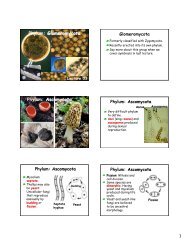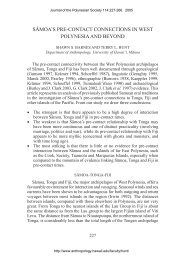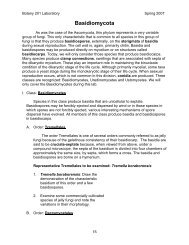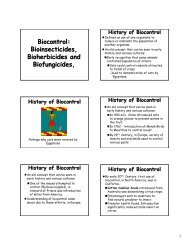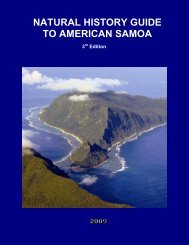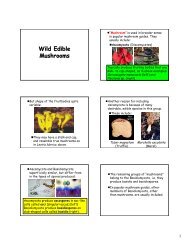american samoa - University of Hawaii at Manoa Botany Department
american samoa - University of Hawaii at Manoa Botany Department
american samoa - University of Hawaii at Manoa Botany Department
- No tags were found...
Create successful ePaper yourself
Turn your PDF publications into a flip-book with our unique Google optimized e-Paper software.
Mr. Whistler was part <strong>of</strong> a three-person field survey team organized by Pedersen PlanningConsultants th<strong>at</strong> observed wetland veget<strong>at</strong>ion, habit<strong>at</strong> for aqu<strong>at</strong>ic fish and invertebr<strong>at</strong>es, streamhydrology, as well as land uses within and adjacent to the wetland. His observ<strong>at</strong>ions aresummarized in the following paragraphs.Stream Mouth to Approxim<strong>at</strong>ely 500 feet UpstreamThe lower portion <strong>of</strong> the Fa<strong>at</strong>afe Streamchannel was highly disturbed. A rock wall,grassy area, and disturbed forest were situ<strong>at</strong>edalong the first 300 feet <strong>of</strong> the west streambank. The forest along the east bank <strong>of</strong> thestream represented a mixture <strong>of</strong> sc<strong>at</strong>teredfresh-w<strong>at</strong>er swamp, mangrove swamp, andlittoral forest trees such as coconut, togo(oriental mangrove), milo (Pacific rosewood),and fau (beach hibiscus).Further upstream, the stream channel widened before turning westward. An <strong>at</strong>tractive, freshw<strong>at</strong>erswamp domin<strong>at</strong>ed by ifi (Tahitian chestnut) was situ<strong>at</strong>ed in this area. Other species inthis loc<strong>at</strong>ion included one or a few individuals <strong>of</strong> oriental mangrove, coconut, laufala(screwpine), and a clump <strong>of</strong> <strong>of</strong>e palagi (bamboo).Soils in this area were s<strong>at</strong>ur<strong>at</strong>ed and quite open since few plants could survive in this wet,shady habit<strong>at</strong>. The forest floor contained only seedlings <strong>of</strong> Tahitian chestnut, clumps <strong>of</strong> sa<strong>at</strong>o(swamp fern), and some falaga (Barringtonia samoensis) trees. Epiphytes were common on thetrees. More prominent epiphytes included the fern lau tasi (Pyrrosia lanceol<strong>at</strong>a), laugasese(Davallia epiphylla), and laugapapa (bird’s nest fern).350 Upstream to North Side <strong>of</strong> WetlandAs the stream turned to the southeast, the veget<strong>at</strong>ion changed significantly and revealed twoother types <strong>of</strong> wetlands.Swamp forest was observed along areas <strong>of</strong> standing or flowing w<strong>at</strong>er. This wetland wasdomin<strong>at</strong>ed entirely by beach hibiscus. The dense tangle <strong>of</strong> branches and shaded canopyvirtually elimin<strong>at</strong>ed all other plant species except for some fue saina (mile-a-minute weed).Disturbed fresh-w<strong>at</strong>er marsh was found both downstream and upstream from the beach hibiscusforest. The marsh was domin<strong>at</strong>ed mostly by sanasana (Job’s tears). Lesser amounts <strong>of</strong> fuelautetele (Merremia pelt<strong>at</strong>a) are also evident in the marsh along with laau fai lafa (candelabra)plants.Along portions <strong>of</strong> this stream segment, the swamp forest and disturbed fresh-w<strong>at</strong>er marshappeared to merge. These loc<strong>at</strong>ions were characterized by sc<strong>at</strong>tered individuals and clumps <strong>of</strong>beach hibiscus, coconut, and g<strong>at</strong>ae palagi (dadap) trees.Job’s tears domin<strong>at</strong>ed underne<strong>at</strong>h these trees. Lesser amounts <strong>of</strong> vao lima (T-grass), mile-aminuteweed, and losa honolulu (Honolulu rose) were also documented.American Samoa Wetland/Stream Restor<strong>at</strong>ion and Enhancement PlanFebruary 2001, V<strong>at</strong>ia Wetland, Page 5-6


